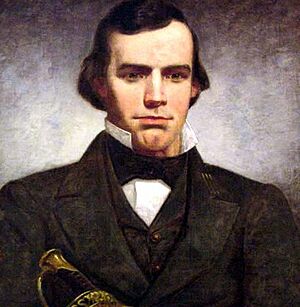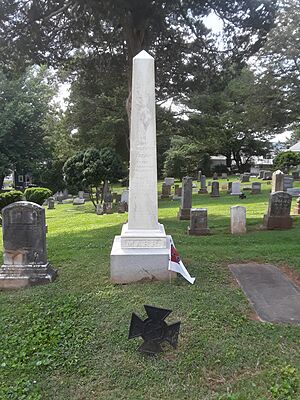John Quincy Marr facts for kids
Quick facts for kids
John Quincy Marr
|
|
|---|---|

Marr in 1849
|
|
| Born | May 27, 1825 Warrenton, Virginia |
| Died | June 1, 1861 (aged 36) Fairfax Court House, Virginia |
| Buried | |
| Allegiance | |
| Service/ |
|
| Years of service | 1861 |
| Rank | |
| Unit | Warrenton Rifles company |
| Battles/wars | |
John Quincy Marr (born May 27, 1825 – died June 1, 1861) was a captain in the Virginia militia. He became the first soldier from the Confederate side to be killed by a Union soldier in a battle during the American Civil War. This happened at the Battle of Fairfax Court House in Virginia on June 1, 1861. Before the war, Marr was a representative for Fauquier County at the Virginia Secession Convention of 1861. He first disagreed with Virginia leaving the Union. However, he later supported the idea, just like many voters did shortly before his death.
Contents
Early Life and Education
John Q. Marr was born in Warrenton, Fauquier County, Virginia, on May 27, 1825. His parents were Catherine Inman Horner Marr and John Marr, Esq. His father was a respected legal official.
John Quincy Marr was a very bright student. He graduated second in his class from the Virginia Military Institute (VMI) in 1846. After graduating, he taught math and military tactics there as an assistant professor. In 1848, he returned home to help care for his mother and sisters. He also took on legal roles similar to his father's. For two years, he served as the sheriff of Fauquier County.
Joining the War Effort
After John Brown's raid on Harpers Ferry, John Q. Marr decided to organize a local militia group. He named this group the "Warrenton Rifles."
In early 1861, the people of Fauquier County elected Marr to be a delegate. He would represent them at the Virginia Secession Convention. At first, Marr was against Virginia leaving the Union. But after much discussion, he eventually signed the document that declared Virginia's secession.
On May 5, 1861, Marr was supposed to become a lieutenant colonel in the Virginia forces. However, he never received this official paper. It was sent to the wrong place by mistake.
The Battle of Fairfax Court House
On Saturday, June 1, 1861, a group of Union Army cavalry soldiers rode into Fairfax Court House. They were on a scouting mission. The town was guarded by two cavalry companies and Marr's Warrenton Rifles infantry company.
As the Union cavalry charged, the Confederate cavalry began to retreat. This cut off some of Marr's men. Only about 40 soldiers from the Warrenton Rifles were in a position to fight the Union cavalry.
Lieutenant Charles Henry Tompkins led the Union force. As they rode through the village, Captain Marr called out, "What cavalry is that?" These were his last words. Shots were fired, and Captain Marr fell dead. It was dark, and no one immediately knew what had happened to him. His body was found later that morning.
After Marr fell, former and future Virginia Governor William "Extra Billy" Smith took command. He was from Warrenton and had helped form the company. Soon after, Lieutenant Colonel Richard S. Ewell arrived. He had just been put in charge of the Confederate forces there. Ewell had been wounded in the shoulder. He took charge of the infantry and moved them to a better position.
The Union cavalry rode through the village, then regrouped and came back. The Warrenton Rifles fired at them, forcing them to turn back. The Confederates fired more shots as the Union soldiers tried to leave town. After three attempts to get through, the Union men had to leave by a different route.
The Confederates reported one dead (Captain Marr), four wounded, and one missing. The Union force lost one killed, four wounded, and three captured.
Aftermath and Legacy
Captain Marr's body was brought back to Warrenton that same evening. The next day, a large crowd gathered for a ceremony before he was buried in the Warrenton Cemetery.
Lieutenant Charles Henry Tompkins, who led the Union charge, later received the Medal of Honor. This was for his brave actions at the 1861 battle. He received the medal in 1893. His award citation says he "shot the enemy's captain." However, other accounts do not specifically say Tompkins personally shot Captain Marr.
On June 1, 1904, a monument to Captain Marr was put up. It was near the entrance of the Historic Fairfax County Courthouse. The monument was later moved in October 2020 to a museum. The monument says: "This stone marks the scene of the opening conflict of the war of 1861–1865, when John Q. Marr, captain of the Warrenton Rifles, who was the first soldier killed in action, fell 800 feet south, 46 degrees West of the spot. June 1, 1861."
First Confederate Soldier Killed
Some people have claimed that Private Henry Lawson Wyatt was the first Confederate soldier killed in the Civil War. He died at the Battle of Big Bethel on June 10, 1861. However, this claim is only true if you consider enlisted men. Captain John Quincy Marr was the first Confederate officer killed in combat. Private Wyatt was the first enlisted man to die in battle.
Images for kids





